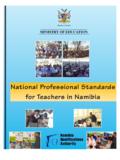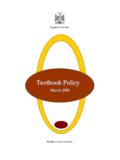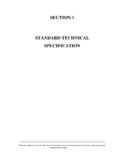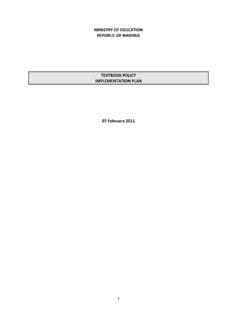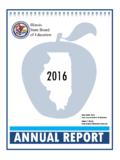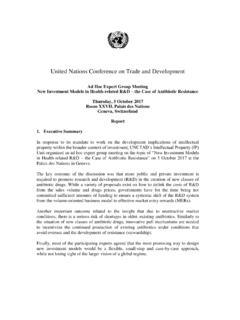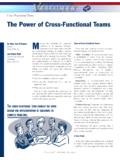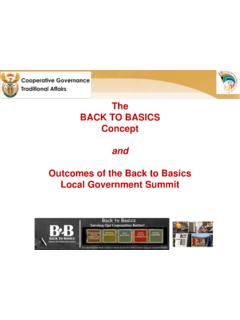Transcription of Education and Training Sector Improvement …
1 REPUBLIC OF NAMIBIA. Education and Training Sector Improvement programme (ETSIP). Planning for a Learning Nation programme DOCUMENT: PHASE I (2006 -2011). FEBRUARY 2007. Acknowledgements The production of this programme document was made possible by intense and continued inputs and support from a large group of stakeholders in the Education and Training Sector . The Ministry of Education acknowledges with gratitude the substantive technical support and guidance provided by the World Bank through various teams of experts under the dynamic leadership of Dr Mmantsetsa Marope. The time, energy and contributions of members of the ETSIP Technical Team (ETT), the ETSIP programme Coordinating Committee, the team leaders of the sub-programmes, the sub- programme development groups, the reference groups for the sub-programmes and in particular the members of the core groups who contributed to this document are also gratefully acknowledged.
2 Comments and inputs received from the review team, members of the Regional Education Forums, participants in the regional consultative meetings and national and international development partners are greatly valued and much appreciated. Copyright 2007, Government of the Republic of Namibia All rights reserved. No part of this publication may be reproduced or transmitted in any form or by any means, electronic of mechanical, including photocopy, recording, or any information storage or retrieval system, without written permission from the Government of the Republic of Namibia. This edition replaces the previous versions dated 17 August 2005, 30 September 2005, 31 October 2005, 22 November 2005, 21 February 2006, April 2006, October 2006 and December 2006.
3 Ii TABLE OF CONTENTS. ACRONYMS iv PREFACE v RATIONALE FOR ETSIP 1. programme OVERVIEW 2. EARLY CHILDHOOD DEVELOPMENT AND PRE- PRIMARY Education 12. GENERAL Education 18. VOCATIONAL Education AND Training 30. TERTIARY Education AND Training 38. KNOWLEDGE CREATION AND INNOVATION 55. INFORMATION, ADULT AND LIFELONG LEARNING 61. INFORMATION COMMUNICATION TECHNOLOGY. (ICT) IN Education 69. HIV and AIDS 79. CAPACITY DEVELOPMENT 85. programme IMPLEMENTATION ARRANGEMENTS. 97. FINANCIAL FRAMEWORK FOR THE programme . 101. RESULTS FRAMEWORK 109. iii ORGANOGRAMME: MINISTRY OF Education 158. ACRONYMS. ACTE Advisory Committee on Teacher Education CBET Competency Based Education and Training CIET Centre for Innovation.
4 Entrepreneurship and Technology COSDEC Community Skills Development Centre CPD Continuous Professional Development DNEA Directorate of National Examinations and Assessment DRFN Desert Research Foundation of Namibia ECD Early Childhood Development EMIS Education Management Information System EPCC ETSIP programme Coordinating Committee ETSIP Education and Training Sector Improvement programme FDIs Foreign Development Investments HAMU HIV and AIDS Management Unit GRN Government of the Republic of Namibia IALL Information, Adult and Life Long Learning ICT Information Communications Technology IMS Information Management System KBE Knowledge Based Economy KIMS Knowledge and Information Management System LTR Learner.
5 Teacher Ratio MoE Ministry of Education MGECW Ministry of Gender Equality and Child Welfare MWTC Ministry of Works, Transport and Communication MIS Management Information System MTP Medium Term Plan MTEF Medium Term Expenditure Framework MTTT Medium Term Technical Team NAMCOL Namibian College of Open Learning NCHE National Council for Higher Education NCRST National Commission on Research, Science and Technology nd NDP National Development Plan (NDP 2 = 2 National Development Plan). NIED National Institute for Educational Development NKIS National Knowledge and Innovation System NPC National Planning Commission NRSTF National Research.
6 Science and Technology Fund NQA Namibia Qualifications Authority NQF National Qualifications Framework NOLNet Namibian Open Learning Network NTA Namibia Training Authority ODL Open and Distance Learning OVCs Orphans and Vulnerable Children PAD Planning and Development PoN Polytechnic of Namibia PQA Programmes and Quality Assurance R&D Research and Development RACE Regional AIDS Committees for Education UNAM University of Namibia VET Vocational Education and Training VTC Vocational Training Centre iv PREFACE. Education and Training in Namibia is at a turning point. We have analysed the Education and Training system in detail.
7 Although the many positive developments, achievements and the progress in the Sector over the last 15 years are recognised and appreciated, the analysis focused on the shortcomings of the system in order to enable us to design an Improvement programme . We now know what is working and what is not working. Indeed, it has been shown quite alarmingly that too many of our children are not gaining the basic skills of functional literacy and numeracy. Progress towards equity in Education has not been rapid enough. More than that, at the current level of performance in Education , we will not be producing citizens who are capable of making Namibia a knowledge-based economy as is expected of us in Vision 2030.
8 There are also serious management and efficiency issues. The salary bill is higher than what the country can afford, even though the lion s share of the national budget is devoted to Education . As a result, vital inputs such as textbooks and library books and other learning materials are being reduced, threatening the quality of learning. Our attention to HIV and AIDS must be sustained. Education must make the pro-poor contribution that is rightly expected of us in the National Poverty-Reduction Strategy. We have taken time, as this document shows, to set objectives and to plan what we must do to turn the system around and bring about big improvements.
9 Namibia has never before had such a detailed, complex and broad-based plan of action for Education . In fact, readers should be aware that for each component mentioned here there is a detailed programme setting out what should be done by whom and by when to achieve it. The time has therefore come for ETSIP to be implemented with energy, and for the effects to be felt on the ground, in the schools and colleges, in vocational Training centres, and wherever organised learning is taking place. Education systems are always difficult to change; they are so huge and involve almost every one of us personally. It is therefore very important that all of us go about this historic change in Education with clarity, determination and unity of purpose.
10 After all, how successful we are in the Education system will largely determine how successful we are in creating that better future that we long for. I am most grateful to the many hands that have developed ETSIP over the past three years: members of staff of the Education Sector Ministries, and of all our kindred institutions and organisations. You have made this our plan. I also wish to extend our thanks to the World Bank, to the European Union and Sida, and to the Bank of Namibia and NamPower, who financed the many studies and preparations that have gone into formulating ETSIP. Without your assistance we may not have got this far, and we look forward to your company on the new road.


